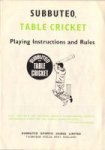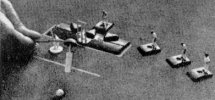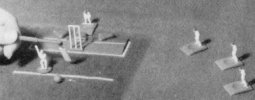
| Peter Upton's |
Subbuteo Tribute Website. |
|
Playing Instructions and Rules. |
|
Page 3: 1960s-80s Cricket Rules (OO Scale) |
Rugby Rules: 1950s; 1960s-80s. Cricket Rules: 1950s; 1960s-80s (this page)
Subbuteo Cricket - Page 1: Box Sets, Page 2: Accessories
Subbuteo Rugby - Page1: Box Sets, Page 2: Accessories, Page 3: Teams
Subbuteo Football boxed editions
These are the rules to the more familiar OO scale Subbuteo cricket produced from the mid 1960s until 1983. New to this edition were the catching bases, the wicket bases, and the score determinator. The catching bases give a more satisfying "catch" than the old method (where the ball simply had to come to rest close to the fielder). The disadvantage to this is that the fielders can no longer be flicked around the pitch to retrieve the ball. This means the method of scoring runs had to change, and so the score determinator triangle was introduced, and this simply measures the distance from the wicket base to determine each score. (The run out rule also changes). The wicket bases are another completely new feature. This adds a bit more skill to bowling, as you can attempt to edge catches to your slips.
These rules were reprinted on several occasions, including 1973 and 1975. The 1973 rules are the ones on this website. The 1975 reprint goes metric, but otherwise the changes are cosmetic. One interesting change are new batting pictures, probably because somebody noticed that the old ones had the bat stuck in a goalkeeper's base like the 1950s version.
SUBBUTEO CRICKET RULES (Advanced)

INTRODUCTION
A match is between two sides of eleven players each, unless otherwise agreed. Each side shall play under a captain who, before the toss for innings, shall nominate his players who may not thereafter be changed without the consent of the opposing captain. No match in which more or less than eleven players a side take part can be regarded as first class; in any case no more than eleven players should field on any one side.
Before the toss for innings, two umpires should be appointed (one for each end) to control the game as required by the laws with absolute impartiality.
All runs scored shall be recorded by scorers appointed for the purpose. The scorers shall accept and acknowledge all instructions and signals given them by the umpires and shall see that the Subbuteo Scoreboard is in accurate condition. Mutual consultation between scorers and umpires to clear up doubtful points is at all times permissible.
THE PITCH
The pitch should be a Subbuteo marked out pitch or a pitch chalked out on any suitable cloth you may possess agreed upon by the two captains to the following measurements:
Outfield boundary lines: 48in. by 32in.
Distance between wickets: 16in.
Bowling crease: 5in. long
Popping crease: 5in. long and 2in. in front of bowling crease
THE MATCH
Each side has two innings, taken alternately except in the situation of a
follow-on. The choice of innings shall be decided by tossing a coin on the field
of play. The winner of the toss may not alter his decision once ha has notified
the opposing captain. The side which bats first and leads by 150 runs after the
first innings are completed shall have the option of requiring the other side to
bat again. In "cup" cricket, time is limited by restricting an innings
to a set number of overs. In friendly games a time limit may be set for an
innings and possibly the match limited to one innings per side.
The captain of a batting side may declare an innings closed at any time
irrespective of the match's duration.
Intervals between innings and other complementary stoppages should be agreed
before the match commences.
SCORING
The scoring shall be reckoned as follows: A "six" is scored by the ball being hit by the batsman clear out of the field and pitching outside the boundary line.
A "four" is scored if the ball crosses over the boundary line after being hit by the batsman. Other scores are made by determining the distance of the ball from the nearest batsman by using the "Score Determinator" . . . one run is scored if the ball is further from the nearest batsman than the measurement of the base of the "Determinator". To score two runs it must be greater than two lengths of the base of the "Determinator", and so on. A "hit" by a batsman is denoted as either when hit by the bat held by the player or if the ball hits the batsman figure and deflects to the field.
A match is won by the side which shall have scored a total of runs in excess of that scored by the opposing side in its two completed innings; a match may be also determined by a side retiring. A match not determined by any of these ways shall be counted as a draw. The result of a match is decided by the runs scored except in the case of a win by the side batting last, when it is by the number of wickets still to fall.
BOWLING
The ball shall be bowled by the bowler (as depicted Photograph 1 with triangle at base) over-arm from each wicket alternately in overs of six or eight balls. The number of balls per over to be determined before the start of play. Neither a "No Ball" or a "Wide" shall count as part of the over.
A bowler may require a batsman at the wicket from which he is bowling to stand on whichever side of the wicket he may direct.
The ball shall be held to be "dead" if it is within the distance of the measurement of the base of the "Score Determinator" from the wicket base, the wicket stops, either batsman figure or the bowler and is not moving. It shall cease to be "dead" when it leaves the bowler directed towards the receiving batsman.
The bowler shall commence to bowl (i.e. be flicked) from behind the delivery crease. Infringement of this rule shall result in the umpire calling "no ball". The ball does not become "dead" on the call of "No Ball". The striker may hit a "No Ball" and whatever runs result shall be added to his score. He cannot be bowled or caught from such a ball, but he can be run out.
A ball is deemed "wide" if it is bowled too high to be reached by the batsman or wide of the wicket base or wicket stops; it may still be hit and runs scored but if this is done the delivery is no longer a "wide", but if runs are run from a "wide" delivery these should be classed as "Extras". If no attempt is made for runs by the batsman one run should be added to the score of the side batting. No runs accredited for a wide should go to the batsman unless, as stated, he hits the ball, when it no longer becomes a "Wide".
It the ball not having been called "wide" or "No Ball" shall pass the striker and subsequently the wicket-keeper and fielders being struck by the bat or batsman figure the umpire shall call a "bye" and any runs forthcoming from this situation shall be deemed "Byes". In Subbuteo, to qualify, the ball shall be within the limits of the wicket base and wicket stop and shall not be stopped or touched by either. The ball shall also pass through the field in the manner stated not higher than the stumps. Runs obtained as "Byes" shall be listed as extras and not credited to the batsman. Any ball being stopped by the wicket stop whether played by the bat or batsman shall be termed "dead" and no runs shall result.
A batsman is bowled if the ball hits the wicket whether the bails are removed or not. For the sake of protecting his wicket a batsman may pat the ball away from it with his bat. He may not hit the ball twice for the purpose of scoring runs or to prevent it being caught by a fielder. Should the umpire decide that this law has been infringed he should give the batsman out "Hit Ball Twice". If the ball hits the wicket, even though the batsman has hit the ball previously he is out. He is also out should he, in endeavouring to hit the ball, break his own wicket. A batsman is "caught" out if the ball lodges (after being hit by batsman or batsman figure) in the indent in the base of a fielder, including the wicket-keeper. It is also out if the ball deflects from the wicket base into the "cup" indent of the fielder base. It is part of the strategy of a bowler that he may either aim at the wicket proper to bowl the batsman or he may aim at the indents of the wicket base to deflect into "cup" of slip fielder base rather as if "edged" by the bat. Slip fielders being placed accordingly. To stimulate the effect of weak batting by the "tail enders" the last three or four batsmen may be given out when the ball is within the triangle limits of the score determinator, similar to the situation when attempting a run-out. The use of the score determinator in this context should be agreed upon by the captains prior to the commencement of play.
|
|
|
L.B.W.
A batsman is given out L.B.W. if the bat wielded by the player misses the ball and the batsman figure in line with the stumps obstructs the ball from hitting them.
RUN OUT
Run outs may be accomplished when a ball struck by the batsman stops in front of a fielder. The "Determinator" may then be used in the following manner . . . taking great care that the fielder figure is not moved in any way, the triangle is placed so that its base indent is close up to the figure's feet; the point of the triangle should point directly forward. This being done, if the ball is now found to be clearly inside the triangular space of the "Determinator" a run out may be attempted. Moving the fielder figure aside the player should use the crook of the fore-finger to troll the ball smartly at either wicket and dislodge the bails. During this operation the ball must not be picked up. To attempt a run out a fielder must be at least two lengths of the determinator away from the nearest batsman. This rule may be modified to stimulate weak scoring by tail enders, i.e. only one length of the determinator for the last three or four batsmen. This modification should be agreed upon by both captains prior to the match commencing.
STUMPING
A batsman is out stumped if the ball rebounds from the wicket-keeper figure and hits the wicket with the batsman out of his ground. The wicket-keeper must always be placed behind the wicket base at all times.
NOTES ON METHODS OF PLAY.
The wicket stands should be placed in the middle of each of the bowling creases. Assemble the stumps and bails in line with the centre of the stands and behind them. Place a 5in. long wicket stop centrally behind and not nearer than 5in. behind the wicket-keeper. The fielding side are placed on the field according to the bowler's directions. The bowler figure should be placed in wicket stand at the bowler's end of the pitch to indicate whether the bowler is operating "round the wicket" or otherwise. (Note: A batsman cannot be out L.B.W. from a ball bowled from round the wicket). The two batsmen figures are placed at their respective creases. The red base carrying the representation of a cricket bat should be kept within handy reach.
BOWLING
Method 1. (For Elementary Method.) - Place the "operational"
bowling figure with the base triangle facing the batsman, put the ball inside
the triangle, aim at the desired target and then flick the back of the base
opposite the triangle smartly and the ball will speed towards the batsman.
Method 2. (For Advanced Method.) - The ball is placed similarly on the wire
triangle but with the wire the opposite way round (i.e. further from the
batsman). After taking aim and having the bowler pointing in the desired
direction, the BACK OF THE FIGURE is flicked with either the first or second
finger, as is found to be the more convenient in order to deliver the ball over
the top of the figure and in the direction of the batsman. Do not use the thumb
as a spring; the thumb does not enter into the delivery of the ball. The
strength and speed of the flick will control the speed of delivery, so as to
represent fast and slow bowling. The setting of the wire in either a flat
position or tending to either right or left before delivery will assist in
varying the actual type of ball bowled.
 |
 |
| Still using an old handle in 1973. | The proper bat handle in 1975. |
BATTING
The wire handle, which is attached to the red base carrying the bat, is held
above the surface of the playing pitch with the bottom of the bat resting on the
playing pitch and with the outstanding wire handle behind the actual batsman
figure (see photograph). The bat is operated by rotating the wire handle between
the thumb and first finger in an imitation of a batting stroke whilst the ball
is being delivered by the bowler, in order to try and hit the ball in a desired
direction (Photograph 4). Leg strokes, off drives, cuts and all the other
strokes of real cricket may be reproduced with practice.
Rugby Rules: 1950s; 1960s-80s. Cricket Rules: 1950s; 1960s-80s (this page)
Subbuteo Cricket - Page 1: Box Sets, Page 2: Accessories
Subbuteo Rugby - Page1: Box Sets, Page 2: Accessories, Page 3: Teams
Subbuteo Football boxed editions
[ Main Page | Previous Page | Next Page ]